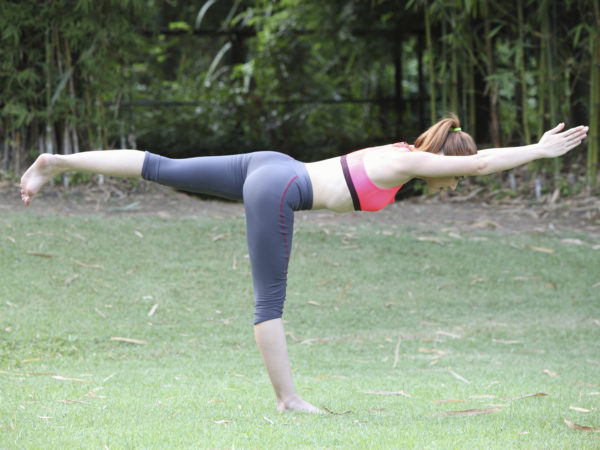Warrior III Pose

“Practicing the Warrior III Pose is difficult but the results I feel after completing it make it a common pose in my yoga routine.” – Andrew Weil, M.D.
Description & History
The Warrior III Pose, termed Virabhadrasana III in Sanskrit, focuses on the muscles of the leg, hips and back while also engaging the core muscles of the torso. The final of the three Warrior Poses, this pose provides both strengthening and balancing benefits.
The Warrior III Pose is the last in the series of Warrior Poses and represents the fierce Hindu warrior Virabhadra. In Hindu mythology, a powerful priest was hosting a sacrifice but did not invite his daughter, Sati, and her husband, Shiva, the supreme ruler of the universe. When Sati discovered the truth, she confronted her father. Overcome with sadness, Sati walked into the fire at the sacrifice, killing herself. When Shiva heard about Sati’s death, he became enraged and created the warrior Virabhadra to avenge Sati’s death. This third version of the Warrior Pose depicts Virabhadra moving swiftly and attacking the enemy.
How to Perform Warrior III Pose
- Start in Tadasana, or standing position with your legs shoulder-width apart and arms at your sides. Step your left foot back about two feet and keep your weight on your right leg. Inhale and bring your arms above your head with palms facing toward each other and perpendicular to the floor.
- Exhale and bending at your hips, lift your left leg up and out as you lower your torso toward the floor. Find a spot on the floor and focus on it to help maintain your balance.
- Try to straighten your legs and arms so your body looks like the letter “T” from the side. Hold and maintain this position for as long as you can, optimally for 30 seconds to one minute.
- To release, exhale and slightly bend your left knee as you bring your right leg down to the floor. Drop your arms to your side as you stand up and end in Tadasana. Reverse your feet and repeat with the right side.
Potential Health Benefits
- Strengthens muscles of the ankles, legs, buttocks, shoulders and back
- Tones core muscles of the abdomen
- Improves balance and body posture
Researchers examined the effects of yoga on balance and flexibility in senior adults. Results of the 12-week study were published in the Archives of Physical Medicine and Rehabilitation. Researchers found at the conclusion of the study that practicing yoga poses, including the Warrior III Pose, increased the participants’ static balance by four percent and their flexibility by 34 percent. The results indicate yoga is a potentially beneficial alternative to traditional exercise and therapy for improving balance and flexibility.
Modifications & Variations
If you are practicing the Warrior III Pose for the first time, it is prudent you take precautions so you do not injure yourself by losing your balance. Brace yourself using a chair to maintain your balance while performing the pose. If you do not have a chair available, use a wall or other secured object that can help hold you in place.
You can modify arm placement a number of ways: if you cannot put your arms in front of you, try leaving them down at your side or outstretched like an airplane.
If you are an advanced practitioner, you can try to bring your outstretched arms to your side and into a reverse Namaste position with palms of the hands pressed together and fingers pointing upward behind your back. This modification changes the position of your torso, so be cautious as you may lose balance.
Another advanced modification is to enter into the Warrior III Pose directly from the Warrior I Pose. To do this, perform the Warrior I Pose with arms stretched above your head and perpendicular to the floor. Exhale and bring your torso down on top of the forward leg. From here, move into the final pose starting from step two above.
Precautions
Use caution when performing the Warrior III Pose if you have high blood pressure. Also, if you have foot, leg, hip or back pain, it is best to avoid the Warrior III Pose. Women who are pregnant can still perform the pose if possible, but it is advised to use the support of a chair or solid item to help maintain balance.
Related Poses
- Warrior I Pose (Virabhadrasana I)
- Warrior II Pose (Virabhadrasana II)
- Wide-Legged Forward Bend (Prasarita Padottanasana)
- Tree Pose (Vrksasana)
- Standing Forward Bend Pose (Uttanasana)
Reviewed by: James Nicolai, M.D., on August 1st, 2013.
Sources
Schmid, Arlene A., Marieke Van Puymbroeck, and David M. Koceja. “Effect of a 12-week yoga intervention on fear of falling and balance in older adults: a pilot study.” Archives of physical medicine and rehabilitation 91, no. 4 (2010): 576-583.









